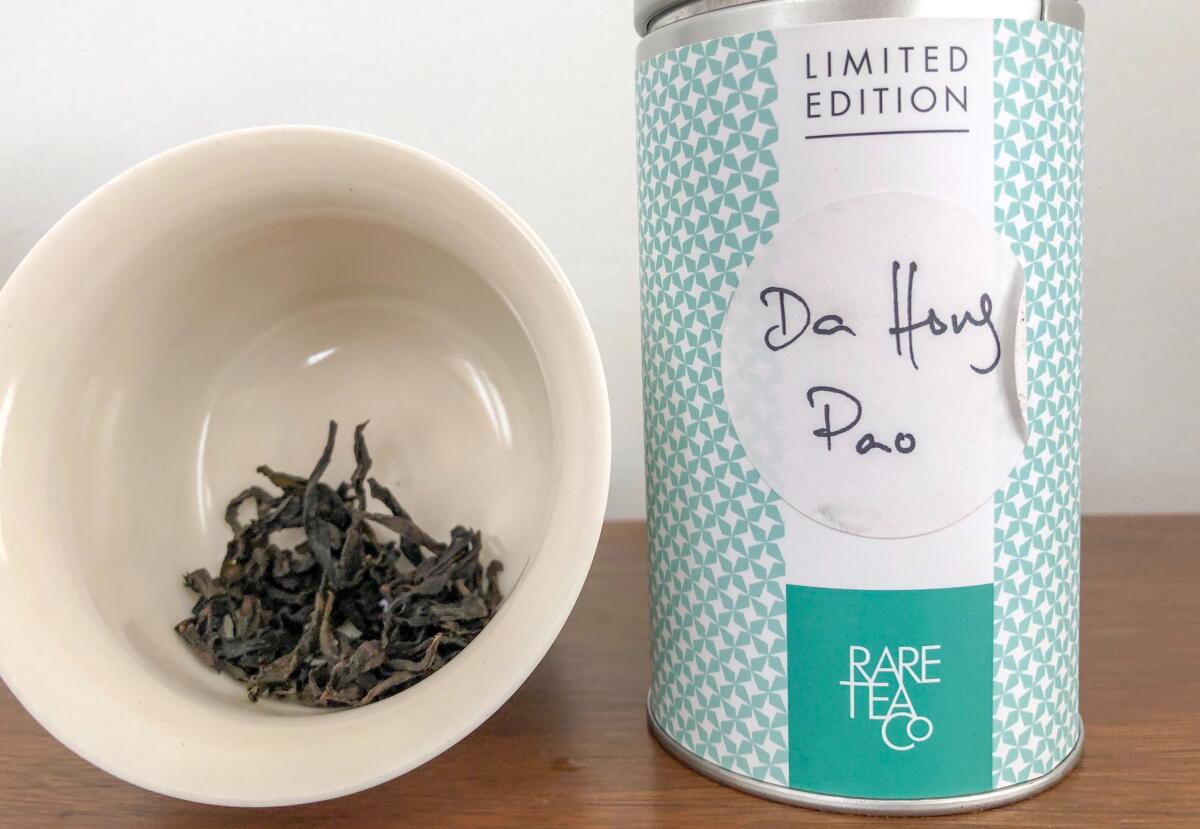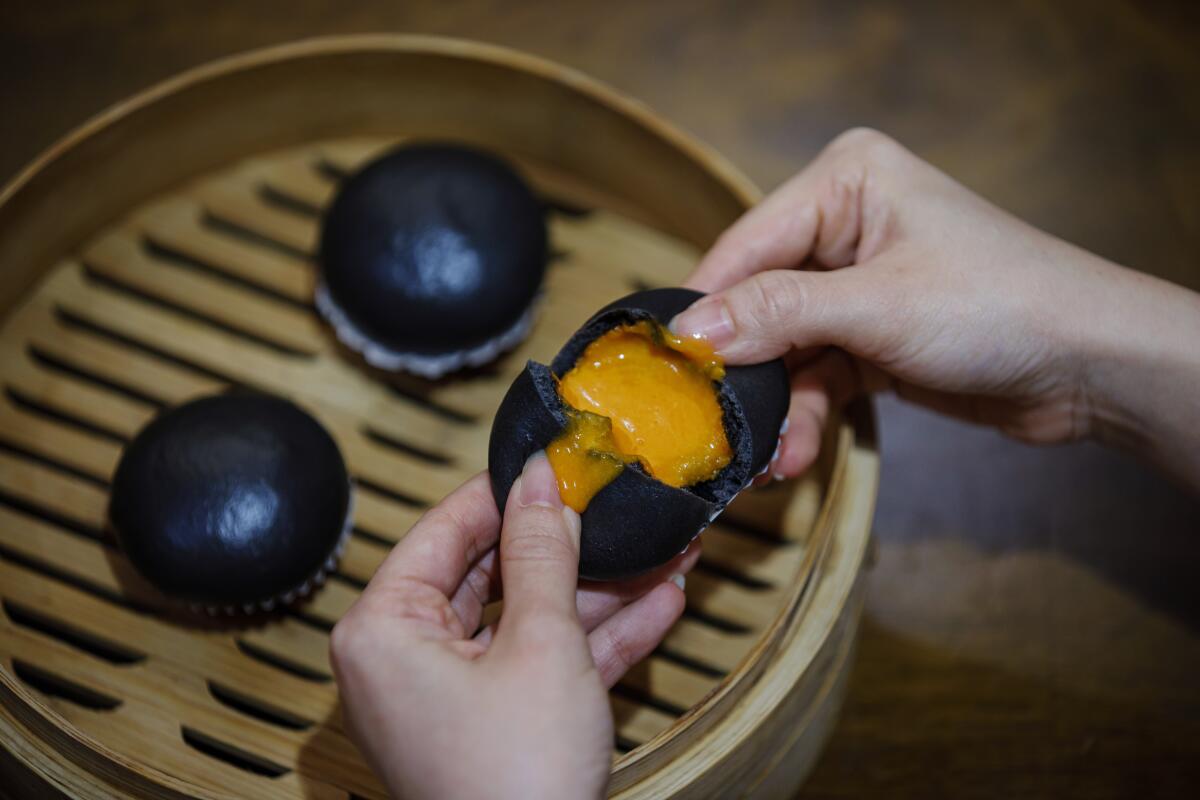Newsletter: The globetrotter who shows us that tea is an adventure
- Share via
If anyone can dislodge narrow notions about tea — that it’s nothing more than a palliative you drink for a cold, or a beverage steeped from a Lipton bag on a rainy afternoon, or an esoteric or boring subject in general — it’s Henrietta Lovell. Fifteen years ago, she left a finance job in New York and founded Rare Tea Company in London. She aimed to start a revolution: Lose the teabag and discover what a cup of the great stuff, in its many forms, can really taste like.
Last month Lovell published her memoir, “Infused: Adventures in Tea.” She’ll be speaking about it on Sunday, Nov. 3, at Chinatown’s Now Serving cookbook store at 6 p.m.
The book’s preface outlines her life: She journeys the world almost ceaselessly, visiting small farms in China, Taiwan, India and Africa that make extraordinary teas, and then working with top-flight restaurants in many countries to introduce those teas to discerning diners using exacting brewing methods. She weaves in fundamental instruction on the primary teas made from the leaves of the camellia sinensis plant — white, green, oolong, black (or red), pu’erh — and there’s a final chapter on the mechanics behind a fantastic cup of tea.
But just as Lovell often shares evocative stories to help her clients connect with the teas she sells, she understands a book on the topic needs to go further than instructions and exploits. She plumbs deeper meanings, from her own life and beyond. This is a chronicle of someone who chose to give herself over to the pursuit of a Big Life, with the triumphs and sacrifices that choice brings.

Her father’s death from cancer propels her to start her own business, to shape her identity as the Tea Lady. Her own grave health crises almost become dares: How badly do you want this? What is the personal cost in leading a professional revolution?
Levity carries many of her narratives. Maybe it’s my recent binge-watching of “Fleabag” (both seasons) but I felt keenly attuned to Lovell’s incisive, sometimes slyly racy British humor. It gives her travelogues wit and context:
“[T]here was a spiced omelette waiting for me and a cup of teabag tea. I passed the teabag back to the man, shook my head and scrunched up my face. He looked at me blankly. Peering into his shed, I could see a fridge full of beer, a kettle, a hotplate, a computer, a stereo with speakers and a hipsterish siphon coffee contraption. We were deep inside Taiwanese tea country and I had a very good cup of coffee. We could have been in Shoreditch.”
She doesn’t sugarcoat the bitter edges of tea’s history, including clear-eyed discussions of how colonialism and class define Britain’s relationship with the beverage. In tracing the evolution of afternoon tea traditions, she acknowledges the World War II-era mentality that cemented tea as a symbol of stiff-upper-lip stoicism. As a culinary insurgent and businessperson she notes, “To some people it can seem like a kind of betrayal to aspire to having fine food or good tea. It’s as if by choosing something better they might be getting above themselves and losing touch with those wonderfully egalitarian times when everyone was in it together.”
And then, in the way that a full life keeps moving, we’re with her at the Chateau Marmont, partying with Anthony Bourdain and making tea-infused cocktails. (It’s here she finds her peace with the American love of iced tea, mastering a technique for cold-brewing that she shares.) There’s fun chef name-dropping too; for example, the tale of a boozy, tea-drunk dinner with Fergus Henderson, who’s bringing his world-famous restaurant St. John to Los Angeles soon.
Speaking of L.A., our city has a relatively nascent tea scene, as I’ve written about previously. If Lovell’s memoir inspires your thirst, Chinatown has a new tea shop called Steep. It’s an ideal place to sit and read over a bowl of lu rou fan (Taiwan’s staple of braised pork over rice), or to venture into the ceremony of gong fu cha with a $20 setup of Jin Xuan, or Taiwanese “milk tea,” that includes two pastries.

I finished the book at home, drinking the last of the Da Hong Pao — an oolong, prized for its wallops of stone fruit and minerality, grown among the Wuyi Mountains of China’s Fujian province — that I bought at Lovell’s store during a 2015 trip to London. As a careerist (and tea obsessive) who’s also embraced bouts of endless travel, I swallowed hard at a line in her dead-honest postscript: “I’m not sure what will become of me, if I will find a modicum of measure.” The quest for balance can be its own turbulent adventure.
Ask the critics
Where do you suggest for solo dining?
—Ben M., Instagram
I think we’re all generally comfortable popping into a burger joint or quick-stop noodle shop or taco stand alone. And there is the occasional joy of dining on one’s own at a blowout restaurant — a symbiotic exchange with a sushi chef (communing with Mori Onodera at Inn Ann in Hollywood is particularly satisfying), or a solo seat at ultra-high-enders such as Hayato and Dialogue. The trickiest strata for solo dining, to me, is in identifying the most fitting midscale restaurants. So here are 10 places, then, that fall in the broad middle of the dining continuum where I’m happy keeping my own company:
Yang’s Kitchen in Alhambra for a bowl of beef noodle soup or lu rou fan. (It happens to be the subject of this week’s review.)
Oxtails or fried chicken and the Lunchbox (a cocktail riff on a PB&J) at Alta Adams in West Adams.
The mozzarella bar at Osteria Mozza. If the burrata from Puglia happens to be available, don’t think; splurge.
A seat at the communal table at Historic Filipinotown’s Porridge + Puffs. Any dish will comfort.
Bestia in the Arts District, if you like a mosh pit of a dining scene into which to disappear. Go for big meat, big pasta, or, in the case of roasted marrow bone over spinach gnoccheti, both at once.
For exactly the opposite — light and calm, though equally sophisticated — treat yourself to a small tin of caviar among the seafood pleasures at Silver Lake’s Ceviche Project.
I found the bar staff particularly warm at Birdie G’s in Santa Monica; aim for a Tuesday for the chicken paprikash over spaetzle, the night’s blue plate special.
Taste of Tehran in Westwood, where I’ve watched solo diners take particular joy in a frequent grilled trout special.
Which reminds me: Joy in Highland Park. Try the spicy shrimp wontons or dan dan noodles with some simple sauteed greens, and then take home a pint of spiced peanuts for a snack (or breakfast).
Yakitori and chawanmushi and sake at Tsubaki in Echo Park. I may opt for this myself tonight.
Top stories

- Fellow critic Patricia Escárcega ventures to Koreatown this week for a review of Openaire at the Line Hotel. She most recommends a bougie brunch over waffles.
- A new xiao long bao specialist is coming to Orange County and wants to dethrone Din Tai Fung and its soup dumpling sovereignty.
- On this week’s episode of “Off Menu,” Lucas Kwan Peterson heads to Orange County for some transcendent Vietnamese food.
- Are your Halloween celebrations spilling into the weekend? Genevieve Ko has some “adult-ish” themed recipes for the occasion.
- Ben Mims brought this persimmon butter cake to the office and, hello, Southern California seasonal fruit wins again.
- New Yorkers! I know some of you are reading. The LAT is hosting a tasting event called Coast to Coast in Manhattan’s Union Park, featuring some of L.A.’s stellar chefs, on Wednesday, Nov. 13. Sqirl’s Jessica Koslow will be there; so will Howlin’ Ray’s Johnny Zone, Mariscos Jalisco’s Raul Ortega, Porridge + Puffs’ Minh Phan and pie queen Nicole Rucker. Also: Superiority Burger. Read about who else will be there (including some of your favorite Food section superstars) and buy tickets here.
More to Read
Eat your way across L.A.
Get our weekly Tasting Notes newsletter for reviews, news and more.
You may occasionally receive promotional content from the Los Angeles Times.











